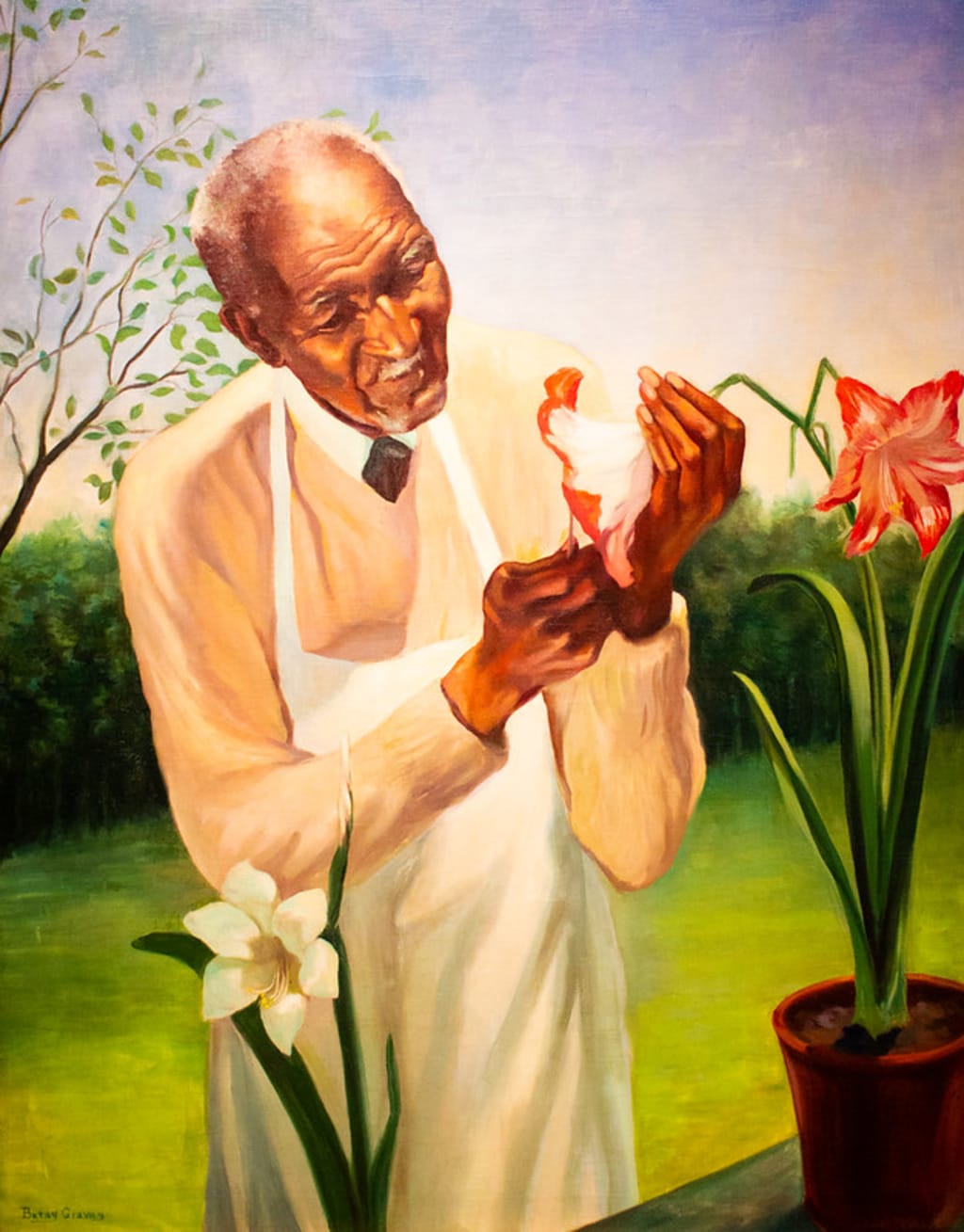
There are few people who walk this earth in kindness, and a devotion to the gentle understanding of the fine balance between nature and man. Its an even greater accomplishment to be a leader in agriculture and create sustainable practices and for those principles to applied many years later. Yet, that is just one of the many accomplishments of George Washington Carver.
George’s early years had a dark beginning. He was born roughly around 1864 in Diamond, Mo. As an infant his father passed away and shortly following George and his mother where kidnapped by slave raiders. Later, George was returned to the same farm in which he was taken, yet his mother was never heard from again. George was not a partially strong child so his work obligations were to do household chores and gardening. The community of woman he grew up with, taught him about plants and the earth. As a young child he developed a passion and connection with plants. His devoted love for plants inspired him to keep a secret garden where one can only imagine the plants whispered into his ears as he became known as “the plant doctor.” Concerned plant owners would bring their sick plants to George for his healing powers. They must have been amazed with his secret language and love with plants as he nursed them back to health.
His passions didn’t stop there. Accomplished in his academics he not only received his Bachelor of Science degree and Master of Science in bacterial botany and agriculture from the now known Iowa State University where he later became the first black faculty member of the University. Acknowledged for accomplishments he was invited to to the Agriculture Department at Tuskegee University, where he remained for 47 years.
George was always drawn to his roots in helping the southern farmers cultivate their land to optimal conditioning, nurturing of soil while keeping the scales balanced and lining the pockets and bellies of the caretakers, the farmers. The southern land had become depleted from the continuous crops of cotton being grown, which at the time many farmers particularly poor African American farmers relied upon. George brought in his wealth of knowledge to assist these farmers in multiple ways. It must have been his mythical connection to the earth that lead him to recognize the sweet potato as the symbol of peace and the root vegetable would serve just as that; bringing peace to over processed, exhausted land. He must have known the peanut symbolized longevity, continuous growth and wealth when introduced this rich crop to the United States. Our maybe it was his background in science knowing these nitrogen-fixing crops would replenish the land. I’m certain it was both, but I still believe in the magical aspect.
When he introduced peanuts, the peanut crops not only fortified the land with nutrients so there could be proper crop rotation while maintaining rich soil, but the peanuts were also an excellent source of food and protein not only for the farmers but for their livestock.
The crops did really well. The peanuts became so abundant that there was now a new problem. What to do with all the peanuts? So George got busy and invited over 300 uses for the peanut. From milk to paper to laxatives to soap and deserts. If the the farmers could utilize their crops in different ways, they could be come more self sufficient and abundant. In addition to the many products for peanuts, he found many uses for the sweet potato as well. He made Molasses, 73 different dyes, cereal, shoe polish and deserts to name a few.
When George wasn’t working on inventing uses for his beloved legumes and root vegetables he was still getting his hands in the soil and creating plant based paints and pigments from clay. He was always touching plants and even bringing their life of pigment to canvas. He loved to paint natural landscapes that were often in his memory bank and reinvented their beauty into a forever memory for all to gaze upon. While working with paint from clay, he said, “That’s just the clay we walk on every day.” He saw the simplicity, complexity and beauty of it all. Yet, he did it in such a logical and magical way. George was an inventor, artist, humanitarian and Botanist. Time Magazine recognized him as a “Black Leonardo” for his greater expression through his eyes, hands and the wisdom derived from his collaboration of art and science. He was full circle and balanced in his creations.
His sustainable practices went far and wide as he was a true child of the earth and an Alchemist and could easily see things others overlooked or maybe didn’t pay attention to. Like, the limits of petroleum use and that there was indeed more value in renewable resources. He said, “I believe the Great Creator has put oil and ores on this earth to give us a breathtaking spell. As we exhaust them, we must fall back on our farms, which is God’s true storehouse and can never be exhausted, for we can learn to synthesize materials for every human need from the things we grow.” It occurs to me, if we would all live by his words, what greatness could we achieve and restoration to the earth that she desperately needs.
George is a legend, an extraordinary man. He was grounded, loved all things in nature, strived to make life more harmonious and abundant for all the creatures and to give thanks to mother earth from who all reside and which we turn to every second of our lives for every need. I find amazement and peace in my heart when I think of him and his capacity of light and knowledge that he has provided us. How many lives he continues to touch every single day. From the little bag of peanuts on the plane we all look forward to (unless you have a peanut allergy) to land that is still yielding crops to care for our bodies.
But I think Franklin Roosevelt may have said it best, "All mankind are the beneficiaries of his discoveries in the field of agricultural chemistry. The things which he achieved in the face of early handicaps will for all time afford an inspiring example to youth everywhere.” [Missouri dept. Agriculture]
A plaque on the wall in the lobby of the George Washington Carver Building at the Missouri Department of Agriculture in Jefferson City, MO reads, “A proud son of Missouri, a true humanitarian, a trailblazer in agricultural science, technology and philanthropy. A role model for persistence, determination, imagination and inspiration in all aspects of our lives.” [Missouri dept. Agricultrure]
With this, I leave you with two sweet endings that I think George would love for us to all enjoy.
Deserts and Sweet Rewards by George:
Peanut and Prune Ice Cream
2 cups of milk, 3 egg yolks, 1/2 pound of pulp from well-cooked and sweetened prunes, 1 quart of heavy cream, 1/2 cup of blanched and ground peanuts, and 1 teaspoon vanilla extract. In Carver's own words: "Heat the milk; pour it into the well-beaten egg yolk; blend all the other ingredients thoroughly. Freeze and serve in dainty glasses" [source: Bulletin No. 31, 1925]. [how stuff works]
Sweet Potato Pie
Boil in skins. When tender, remove skins; mash and beat until light. To each pint of potatoes, add 1/2 pint of milk, 1/2 pint of cream and four well-beaten eggs; add 1 1/2 teacups of sugar (less if the potatoes are very sweet). Add spice, cinnamon and ginger to taste; one ground clove will improve it. Bake with bottom crust only [source: Bulletin No. 38, 1936]. [how stuff works]
Sources:
America’s Story from America’s Library http://www.americaslibrary.gov/aa/carver/aa_carver_peanut_3.html
National Peanut Board https://www.nationalpeanutboard.org/
Missouri Department of Agriculture https://agriculture.mo.gov/gwc.php
How Stuff Works https://science.howstuffworks.com/innovation/famous-inventors/george-washington-carvers-inventions.htm
About the Creator
Jenna W.
Writing is one of my favorite forms of creative expression. I was first published at 14 and continue to enjoy storytelling and producing educational pieces as well. Thanks for your interest & taking the time to read my words!






Comments
There are no comments for this story
Be the first to respond and start the conversation.